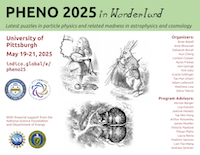Speaker
Description
We consider 2-to-2 scatterings of Higgs bosons in a CP-conserving two-Higgs-doublet model (2HDM) and study the implication of maximizing the entanglement in the flavor space, where the two doublets $\Phi_a$, $a=1,2$, can be viewed as a qubit: $\Phi_1=|0\rangle$ and $\Phi_2=|1\rangle$. More specifically, we compute the scattering amplitudes for $\Phi_a \Phi_b \to \Phi_c \Phi_d$ and require the outgoing flavor entanglement to be maximal for a full product basis such as the computational basis, which consists of $\{|00\rangle,|01\rangle,|10\rangle,|11\rangle\}$. In the unbroken phase and turning off the gauge interactions, entanglement maximization results in the appearance of an $U(2)\times U(2)$ global symmetry among the quartic couplings, which in general is broken softly by the mass terms. Interestingly, once the Higgs bosons acquire vacuum expectation values, maximal entanglement enforces an exact $U(2) \times U(2)$ symmetry, which is spontaneously broken to $U(1)\times U(1)$. As a byproduct, this gives rise to Higgs alignment as well as to the existence of 6 massless Nambu-Goldstone bosons. The $U(2)\times U(2)$ symmetry can be gauged to lift the massless Goldstones, while maintaining maximal entanglement demands the presence of a discrete $\mathrm{Z}_2$ symmetry interchanging the two gauge sectors. The model is custodially invariant in the scalar sector, and the inclusion of fermions requires a mirror dark sector, related to the standard one by the $\mathrm{Z}_2$ symmetry.

